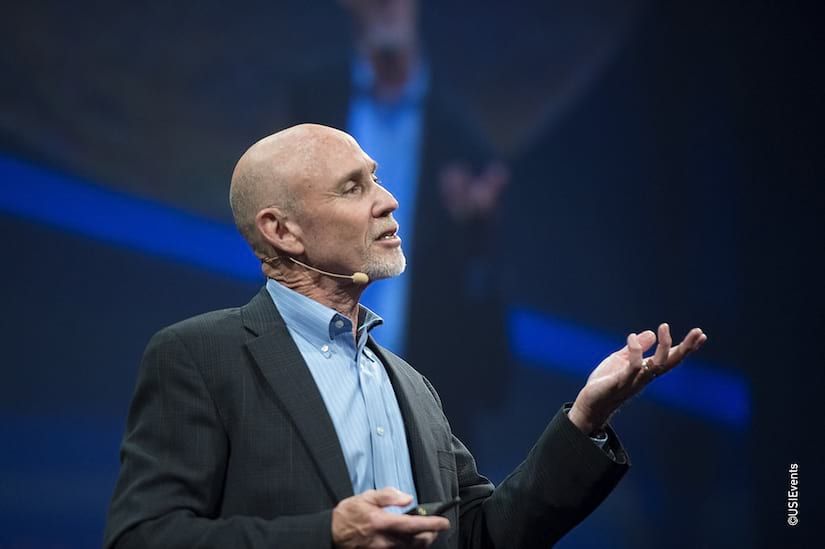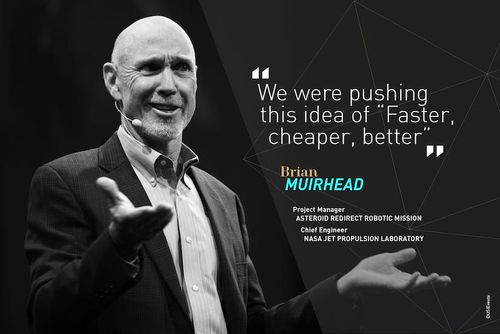Brian Muirhead : Going to Mars
A question of leadership, creativity and organisation.
“I have this vision of a future where men are on Mars. I dream of a mother looking at the sky with her child, telling him that’s where she comes from.” Brian Muirhead knows about failure. In 1978, he was a member of the Jet Propulsion Laboratory (JPL) and headed the design, development and launch of the Mars Pathfinder, the first machine to land on Mars. According to him, the secret to taking risks without failing resides in being creative in what we do and how we do it.
Mars: a story of success and failure
In the 19th century, many had already speculated on the existence of a Martian civilization. During the first Mars flyby in 1964, the technology of the time showed a dry, flat and lifeless surface. In 1976, the most sophisticated and costly field mission was put together. Once again, given the results, life on the surface of the red planet seemed impossible. Suddenly, general disinterest grew among scientists.
Two decades later, interest on Mars grew again and various missions were launched (Cassini, Galileo…). But the fall of the USSR led to a drastic decrease in the funding of those projects. The NASA then decided to launch missions with a more restrained budget but a more efficient approach. The result was, on July 4th, 1997, the landing of the Mars Pathfinder on the red planet in line with the allocated budget and timeline.
At the time, media interest increased yet again. The NASA promised to publish the data and results of those missions on the web. But in 1999, the Mars Climate Orbiter failed as it was being put into orbit. After this failure, scientists became reluctant to take risks. Curiosity, a mobile biochemist robot able to take samples from the surface of the planet, was created. At the time, there were ten successful landings on Mars against twenty failed attempts. Today, the ratio is twenty-one successes for twenty failures.
The "7 minutes of terror"
The landing process on the red planet is complex. And it can only be tested on Mars. Even with very precise technologies… By way of summary, it is a 7 minute deployment, during which an 8kg machine launched at 3500 km/hr must land. An internal computer must alone operate an entry that is almost parallel to the Martian atmosphere which is not as dense as the Earth’s atmosphere and which cannot slow down a vertical entry. Then, the vessel uses a parachute (the greatest and most resistant in the world) to break the descent. The landing (between the atmosphere and the ground) is the most critical moment. The capsule must then detach from the vessel and fly horizontally with the explorer hanging from it with threads all the way to the bottom of a crater.
The ingredients for success
According to Brian Muirhead, all these results were made possible thanks to a team that is “strongly committed to the mission and confident in its success”. It is also necessary to build a very diverse team so as to foster creativity. Emotional intelligence, will and determination are also key, as well as clear and effective communication. In terms of leadership, trusting one’s team is essential. Brian Muirhead adds: “As they often say, you need glue and oil to ensure fluid relations between unit managers and team members”.
In other words, cutting-edge technology and a good organization are key factors to complete missions. As for methodology? Test, test and test again. Until you reach success. Indeed, past tests and failures can be positive factors in a mission.
Are we alone in this universe?
All the work carried out during those missions tries to bring an answer to this question. Up to now, the JPL has discovered that there are sedentary rocks on the surface of Mars. This could mean the presence of water on Mars. Curiosity showed scientists that it is possible to dig under the surface to obtain samples, the chemical composition of which can be analyzed. As for the future, Brian Muirhead’s team is looking to discover whether there once was life on the planet.
Science-fiction shows a very real perspective of possible human life on Mars, but the truth is that this is still far from becoming a reality. A more realistic perspective, to reach this objective, would be to start by sending a team on the Moon on a permanent basis and to organize outings towards Mars that would head back to the Moon each time.
Brian Muirhead pilots the Asteroid Redirect Robotic mission, the objective of which is to put into orbit a small 7m-diameter and 500-ton asteroid around the Moon in order for manned mission crews to study it.
Recommended :

